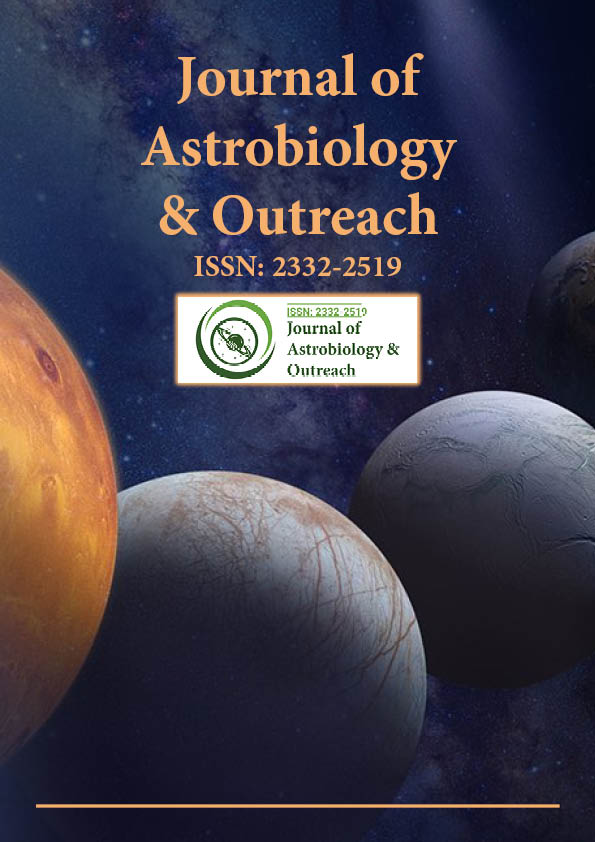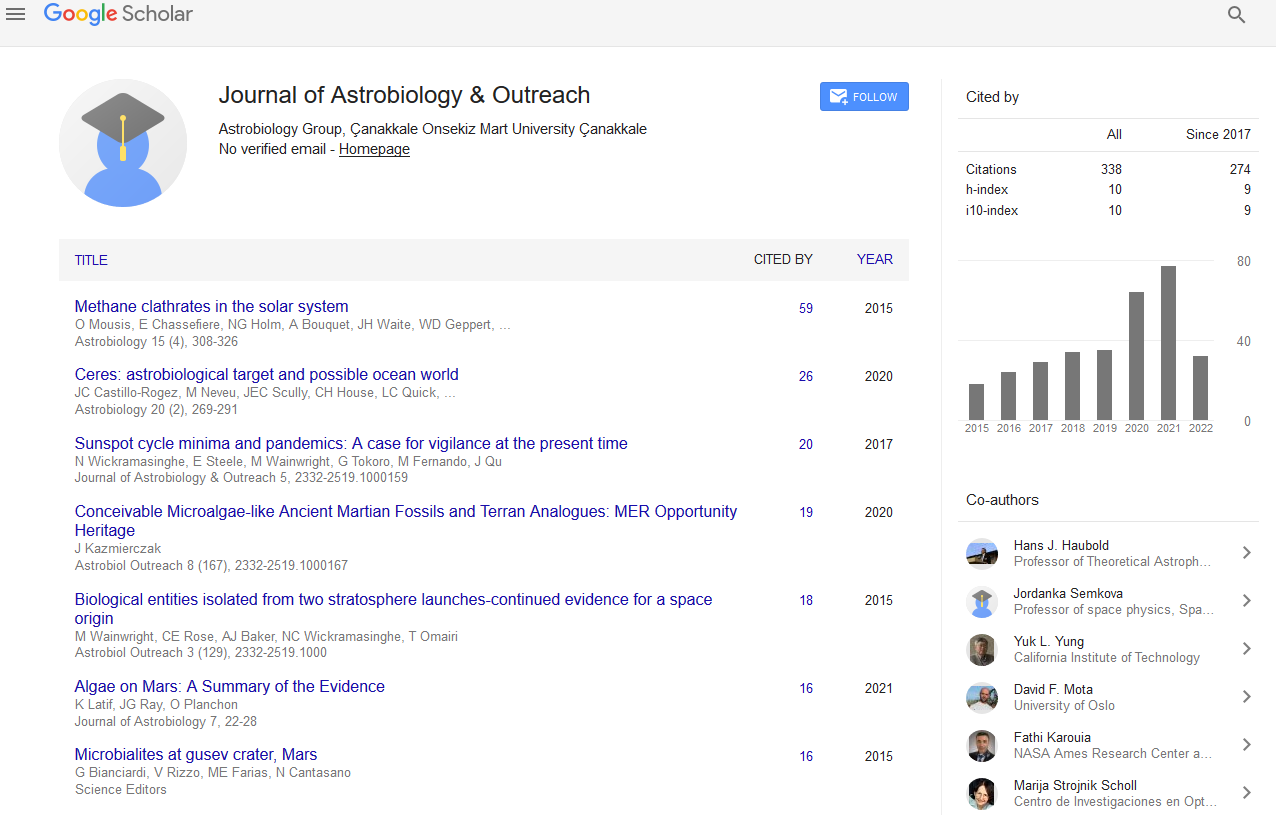Indexed In
- Open J Gate
- Academic Keys
- JournalTOCs
- RefSeek
- Hamdard University
- EBSCO A-Z
- OCLC- WorldCat
- Google Scholar
Useful Links
Share This Page
Journal Flyer

Open Access Journals
- Agri and Aquaculture
- Biochemistry
- Bioinformatics & Systems Biology
- Business & Management
- Chemistry
- Clinical Sciences
- Engineering
- Food & Nutrition
- General Science
- Genetics & Molecular Biology
- Immunology & Microbiology
- Medical Sciences
- Neuroscience & Psychology
- Nursing & Health Care
- Pharmaceutical Sciences
Commentary - (2025) Volume 13, Issue 2
Astrobiology Outreach in the Potential Havens for Life beyond Planets
John Edgar*Received: 16-Dec-2023, Manuscript No. JAO-23-24457; Editor assigned: 19-Dec-2023, Pre QC No. JAO-23-24457; Reviewed: 02-Jan-2025, QC No. JAO-23-24457; Revised: 22-Feb-2025, Manuscript No. JAO-23-24457; Published: 09-Feb-2025, DOI: 10.35248/2332-2519.25.13.372
Description
Astrobiology, the interdisciplinary scientific field that investigates the origin, evolution, and distribution of life in the universe, has captured the imagination of scientists and the public alike. As our understanding of the cosmos expands, so does the realization that life may exist beyond our own planet. Astrobiology outreach plays a vital role in bridging the gap between scientific exploration and public understanding, offering insights into the potential havens for life beyond Earth.
Astrobiology encompasses a wide range of scientific disciplines, including biology, chemistry, physics, astronomy, and geology. The primary goal is to unravel the mysteries surrounding the emergence of life and its existence beyond the confines of Earth. Scientists seek to identify and study celestial bodies that may harbor the necessary conditions for life to flourish, giving rise to the concept of potential havens beyond our planet. The search for life beyond Earth extends beyond the traditional boundaries of our solar system. Exoplanets, planets located outside our solar system, have become focal points of astrobiological investigations. Scientists are particularly interested in exoplanets situated within the habitable zone, also known as the Goldilocks zone.
Mars, next planet, has long been a target for astrobiological exploration. Recent missions, such as NASA's perseverance rover, are equipped with advanced instruments to analyze the Martian surface for signs of past or present microbial life. While Mars may not currently support complex life, its history suggests that it may have harbored conditions suitable for basic life forms in the past. Astrobiologists are also focused on Enceladus and Europa, two of Jupiter's and Saturn's moons, respectively. These icy moons possess subsurface oceans beneath their frozen surfaces, raising the possibility of life thriving in the dark, hidden depths. Space agencies are considering future missions to these moons to explore their potential habitability.
As scientific discoveries unfold, astrobiology outreach becomes an essential tool for engaging the public and fostering a deeper understanding of the implications of these findings. Educational programs, public lectures, and interactive exhibits serve as platforms to convey the excitement and significance of astrobiology. The integration of multimedia, including documentaries and podcasts, helps make complex scientific concepts accessible to a broader audience. Furthermore, partnerships between scientists, educators, and science communicators facilitate the development of outreach initiatives. Collaborative efforts ensure that accurate and captivating information about astrobiology reaches diverse communities, sparking curiosity and inspiring the next generation of scientists. Astrobiology outreach extends beyond traditional educational settings, reaching out to the public through various channels. Social media platforms, science festivals, and citizen science projects provide opportunities for individuals to actively participate in the scientific process.
Citizen scientists can contribute to the analysis of astronomical data, fostering a sense of connection to the ongoing search for space life. The representation of astrobiology in popular culture also plays a pivotal role in shaping public perceptions. Films, television shows, and literature have the power to captivate audiences and generate interest in scientific activities. By collaborating with the entertainment industry, scientists can present accurate depictions of astrobiology while harnessing the creative elements that make science fiction compelling. Astrobiology outreach must also address ethical considerations related to the potential discovery of extraterrestrial life. Contemplating the existence of life beyond Earth raises questions about our responsibility to protect and preserve these potential life forms. Outreach initiatives should foster discussions on the ethical implications of scientific exploration and guide societal responses to potential future discoveries. Astrobiology outreach stands at the forefront of connecting scientific exploration with public understanding, offering glimpses into the potential havens for life beyond Earth. As technological advancements continue to expand our reach into the cosmos, engaging the public in the excitement of astrobiology becomes increasingly essential.
Citation: Edgar J (2025) Astrobiology Outreach in the Potential Havens for Life beyond Planets. J Astrobiol Outreach. 13:372
Copyright: © 2025 Edgar J. This is an open-access article distributed under the terms of the Creative Commons Attribution License, which permits unrestricted use, distribution, and reproduction in any medium, provided the original author and source are credited.

